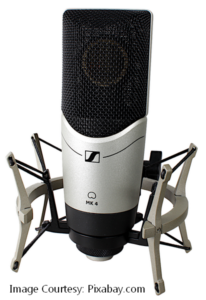 Introduction
Introduction
It is important that you understand the pivotal role of microphones in delivering top-notch audio recordings. Among the vast array of microphones available, condenser microphones stand out for their remarkable sensitivity and crystal-clear sound. In this comprehensive guide, we will delve into the specifications, advantages, and disadvantages of condenser microphones, highlighting their versatility and role in various recording and broadcasting applications.
Specifications of Condenser Microphones
- Diaphragm Type: Condenser microphones boast a thin diaphragm that responds dynamically to sound waves, converting them into precise electrical signals.
- Polar Pattern: Versatility is key with condenser mics, offering a wide selection of polar patterns, such as Cardioid, Omnidirectional, Figure-eight, and more. This empowers you to control the microphone’s sensitivity to sound from different directions, tailoring it to your specific recording needs.
- Frequency Response: With an expansive frequency response range, condenser microphones effortlessly capture both high and low-frequency sounds, preserving every nuance in the audio spectrum.
- Sensitivity: Renowned for their high sensitivity, condenser mics excel in capturing delicate sounds, be it intimate vocal performances or intricate instrumental details, delivering an unparalleled audio experience.
- Power Requirements: It’s essential to note that many condenser microphones require external power (phantom power). However, this power can be easily supplied by mixing consoles, pre-amps, or audio interfaces, making them readily accessible for professional setups.
- Output Type: Condenser mics typically offer a low output impedance, ensuring a robust signal level, minimizing the need for additional amplification.
- Self-Noise: Condenser microphones exhibit lower self-noise levels compared to dynamic microphones, resulting in cleaner recordings, particularly in quieter environments.
Pros of Condenser Microphones
- High-Quality Sound: Condenser microphones impress with their exceptional audio quality and flat frequency response, capturing a wide range of frequencies with remarkable precision.
- Sensitivity: Their unparalleled sensitivity enables them to capture the finest nuances in sound, making them ideal for capturing emotive vocals and expressive instruments.
- Transients and Fast Response: Condenser mics excel at capturing swift transients, making them the go-to choice for recording instruments with sharp attacks, such as acoustic guitars and percussion.
- Versatility: The abundance of polar patterns renders condenser microphones versatile, accommodating diverse recording scenarios, from intimate solo performances to dynamic group interviews or instrument ensembles.
- Low Self-Noise: The minimal self-noise of condenser mics ensures pristine recordings, especially in noise-sensitive environments.
- Extended Frequency Response: Offering a broad frequency response range, condenser microphones flawlessly capture the full richness of sound, enhancing the overall recording experience.
- Suitable for Studio Recording: Thanks to their superior fidelity, condenser mics are an indispensable asset in studio environments, delivering stellar results for vocal and instrumental recordings.
Cons of Condenser Microphones
- Fragility: Condenser microphones are more delicate compared to dynamic mics, requiring cautious handling to prevent physical damage or humidity-related issues.
- Power Requirements: Some condenser mics rely on external power (phantom power), which might limit their compatibility with certain devices and setups.
- Handling Noise: Due to their sensitivity, condenser mics can pick up handling noise and vibrations, necessitating the use of shock mounts or isolation solutions.
- Sibilance and Plosives: If not equipped with pop filters or positioned correctly, condenser microphones can accentuate sibilant sounds (S, T, SH) and plosives (P, B), potentially disrupting recordings.
- Price: High-quality condenser microphones may entail a higher cost compared to dynamic options, particularly in the realm of professional-grade studio microphones.
- Noisy Environments: They may not be the optimal choice for noisy environments or live performances where feedback and ambient noise could pose challenges.
- Phantom Power Dependency: As condenser microphones require a power source, a failure in the phantom power supply during a recording session could disrupt the process.
Conclusion
Despite their limitations, condenser microphones remain an integral part of the Sound Engineer’s toolkit, boasting unmatched sound quality, versatility, and sensitivity. From recording studios and podcasts to streaming and professional broadcasting, condenser microphones are the top choice for achieving exceptional audio recordings that leave a lasting impression on listeners. As you embark on your audio journey, armed with this knowledge, you can confidently choose the perfect condenser microphone to elevate your sound engineering endeavors.
